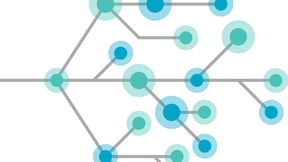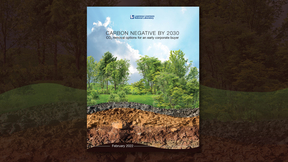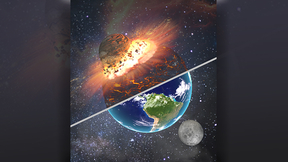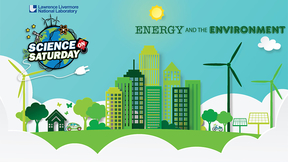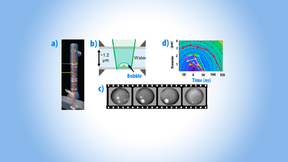Back
Carbon exhibits a remarkable tendency to form nanomaterials with unusual physical and chemical properties, arising from its ability to engage in different bonding states. Many of these “next-generation” nanomaterials, which include nanodiamonds, nanographite, amorphous nanocarbon and nano-onions, are currently being studied for possible applications spanning quantum…
Lawrence Livermore National Laboratory (LLNL) scientists exploring the interaction between cancer cells and the extracellular matrix (ECM) — the “scaffolding” of organs — found that proteins in the ECM can dramatically impact the immune system’s ability to kill tumors. Researchers said the findings, published online in the journal Biomaterials, could represent a novel…
In the National Ignition Facility (NIF), the world’s highest-energy laser system, a complex series of glass optics — including amplifiers, mirrors, wavelength converters and focusing lenses — strengthens and guides the laser light to its destination. Over the years, researchers have developed and refined these optics so they can withstand the intense energies generated by…
Lawrence Livermore National Laboratory’s decades of leadership in developing high-energy lasers is being tapped to provide a key component of a major upgrade to SLAC National Accelerator Laboratory’s Linac Coherent Light Source (LCLS). Over the next several years, LLNL’s Advanced Photon Technologies (APT) program will design and construct one of the world’s most powerful…
If a cancer patient tests positive for COVID-19, are they more likely to become hospitalized from the disease? That depends on certain risk factors, according to a new study by researchers at Lawrence Livermore National Laboratory (LLNL) and the University of California, San Francisco (UCSF), who looked to identify cancer-related risks for poor outcomes from COVID-19…
An international team led by scientists from the University of Oxford Department of Physics, the University of Rochester and the University of Chicago turned to Lawrence Livermore National Laboratory’s (LLNL’s) National Ignition Facility (NIF) to help unravel the inner workings of heat conduction in clusters of galaxies — the largest structures in the universe. These…
In findings that could help advance another “viable pathway” to fusion energy, research led by Lawrence Livermore National Laboratory (LLNL) physicists has proven the existence of neutrons produced through thermonuclear reactions from a sheared-flow stabilized Z-pinch device. The researchers used advanced computer modeling techniques and diagnostic measurement devices…
Whether dead or alive, soil microorganisms play a major role in the biogeochemical cycling of carbon in the terrestrial biosphere. But what is the specific role of death for the bacteria, fungi and microfauna that make up the soil microbiome? That is the topic of a new review by Lawrence Livermore National Laboratory (LLNL) scientists and collaborators. The article,…
An international team of scientists has found new biomarkers that can be used for diagnostic purposes and potentially as predictive tools of the risks associated with deep-space flight. In their study, the team, including three researchers from Lawrence Livermore National Laboratory (LLNL), examined approximately two-decade-old blood samples from space shuttle astronauts…
Since the Industrial Revolution, atmospheric carbon dioxide (CO2) levels have continued to rise. While oceans, plants, and soils can sequester some of this CO2 naturally, they cannot capture and remove it all, causing the excess to make its way into the atmosphere. Long-term storage solutions are needed to address the surplus—a contributor to climate change—and help the…
The Department of Energy’s (DOE’s) Early Career Research Program (ECRP) aims to bolster the nation’s scientific workforce by providing support to exceptional researchers at U.S. academic institutions and DOE’s national laboratories during their early career years. Annually, ECRP provides research funding to full-time staff in their first 10 years post-doctorate.
Research conducted at Lawrence Livermore National Laboratory (LLNL) describes a validation exercise for simple models used to understand hot-spot conditions reached in an implosion, which find good agreement when compared to a set of simulations. Progress toward ignition requires accurately diagnosing current conditions and assessing proximity metrics for implosion…
Lawrence Livermore National Laboratory (LLNL) scientists have provided input on Microsoft’s pathway to become carbon-negative by 2030. LLNL researchers built on their pivotal report "Getting to Neutral: Options for Negative Carbon Emissions in California," which has become a trusted adviser in the discussion of how to remove carbon dioxide from the air, to make…
Most metal alloys are prone to corrosion, which costs hundreds of billions of dollars of damage annually in the U.S. alone. Accurately predicting corrosion rates is a long-standing goal of corrosion science, but these rates depend strongly on the specific operating environment. At the atomic scale, these environmental factors are associated with how quickly and easily…
A major cost of running the National Ignition Facility (NIF) is managing and mitigating laser-induced damage to optics as the laser beams propagate to the target. Another damage mechanism stems from stimulated Brillouin scattering (SBS) as light travels back from the target and with nearly the same wavelength as the incoming light. This SBS has the potential to cause…
The Department of Energy (DOE) Project Leadership Institute (PLI) has selected Lawrence Livermore National Laboratory’s Lara Leininger and Al Churby as 2022 cohort participants. Members of the PLI cohort have demonstrated their expertise as technical, business systems or project leaders, with significant experience and responsibility for project or organization performance…
Earth’s supply of water is incredibly important for its ability to sustain life, but where did that water come from? Was it present when Earth formed or was it delivered later by meteorites or comets from outer space? The source of Earth’s water has been a longstanding debate and Lawrence Livermore National Laboratory (LLNL) scientists think they have the answer — and they…
Lawrence Livermore National Laboratory (LLNL), Penn State (PSU) and University of Arizona (UA) researchers are partnering with industry collaborator Western Rare Earths (WRE), U.S. subsidiary of American Rare Earths Limited, to use a naturally occurring protein to extract and purify rare earth elements (REEs) from abundant, domestic ore-based feedstocks and waste materials…
WHO: Lawrence Livermore National Laboratory (LLNL) scientists Xavier Mayali and Ty Samo, along with teacher Erin McKay of Tracy High School, will present “Small Algae, Big World: The Impact of Microalgae on Global Carbon Cycling and Sustainable Biofuels,” the second lecture in the 2022 virtual Science on Saturday series that highlights Energy and the Environment. WHAT:…
The formation and collapse of microscopic bubbles is important in a wide range of fields as both a potential mechanism behind tissue damage, such as in cases of blast-wave-induced traumatic brain injury, and as a useful tool for technology applications, such as mechanical properties evaluation, nanomaterials manipulation and surface cleaning. Nanobubbles have been of…











